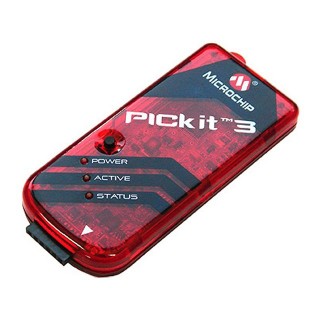- Pin (3)
- Quang điện (1)
- Vi điều khiển (22155)
- Bộ nhớ (4105)
- Không dây (93)
- Connector (26)
- Linh kiện rời rạc (104)
- Relay (305)
- Cảm biến (17)
- Công cụ phát triển (3)
- Linh kiện tuyến tính (2)
- Linh kiện thụ động (545)
- Quản lý nguồn (1895)
- Mạch phát triển (0)
- Máy tính nhúng (47)
- Thiếc hàn, chì hàn (3)
- Thiết bị sản xuất (7)
- Sản phẩm R&P (6)
Tìm kiếm bài viết
Tìm kiếmPICkit 3 In-Circuit Debugger
|
||||||||||||||||||||
PICkit 3 In-Circuit Debugger
|
Microchip’s PICkit 3 In-Circuit Debugger/Programmer uses in-circuit debugging logic incorporated into each chip with Flash memory to provide a low-cost hardware debugger and programmer. In-circuit debugging offers these benefits:
The PICkit 3 can now also reprogram any PIC microcontroller with a simple push of a button: |
|
Note: The PICkit 3 In-Circuit Debugger/Programmer is NOT a production programmer. It should be used for development purposes only.
The MPLAB PICkit 3 allows debugging and programming of PIC® and dsPIC® Flash microcontrollers at a most affordable price point using the powerful graphical user interface of the MPLAB Integrated Development Environment (IDE). The MPLAB PICkit 3 is connected to the design engineer's PC using a full speed USB interface and can be connected to the target via an Microchip debug (RJ-11) connector (compatible with MPLAB ICD 2, MPLAB ICD 3 and MPLAB REAL ICE). The connector uses two device I/O pins and the reset line to implement in-circuit debugging and In-Circuit Serial Programming™.
PICkit 3 Features
- USB (Full speed 12 Mbits/s interface to host PC)
- Real-time execution
- MPLAB IDE compatible (free copy included)
- Built-in over-voltage/short circuit monitor
- Firmware upgradeable from PC/web download
- Totally enclosed
- Supports low voltage to 2.0 volts (2.0v to 6.0v range)
- Diagnostic LEDs (power, busy, error)
- Read/write program and data memory of microcontroller
- Erase of program memory space with verification
- Freeze-peripherals at breakpoint
- Program up to 512K byte flash with the Programmer-to-Go
Header Information
Some 8-, 14- and 18-pin devices use small header boards with a special MCU for debugging. This special MCU has extra pins for PICkit 3 communication and therefore allows the use of all pins on the part for the application. The header board is not used or needed for programming. However, when debugging these devices the header must be used. See the "Header Specification" document below or see a list of current devices that use headers here.
| Product | |
| Datasheet | http://ww1.microchip.com/downloads/en/DeviceDoc/PICkit_3_User_Guide_51795A.pdf |
| Microcontroller | |
| Package | MPLAB Emulators and Debuggers |


 Tags:
Tags:
